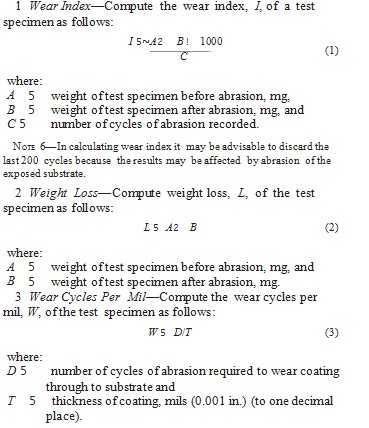Test Method for Abrasion Resistance of Organic Coatings

ASTM D406-This test method covers the determination of the resistance of organic coatings to abrasion produced by the Taber Abraser on coatings applied to a plane, rigid surface, such as a metal panel.
This standard does not purport to address all of the safety concerns, if any, associated with its use. It is the responsibility of the user of this standard to establish appropriate safety and health practices and determine the applicability of regulatory limitations prior to use.
The organic coating is applied at uniform thickness to a plane, rigid panel and, after curing, the surface is abraded by rotating the panel under weighted abrasive wheels.Abrasion resistance is calculated as loss in weight at a specified number of abrasion cycles, as loss in weight percycle, or as number of cycles required to remove a unit amount of coating thickness.
Test Specimens
Apply a uniform coating of the material to be tested to a plane, rigid panel. Specimens shall be a disk 4 in. (100 mm)in diameter or a plate 4 in. (100–mm) square with rounded corners and with a 1⁄4-in. (6.3-mm) hole centrally located on each panel. Prepare a minimum of two coated panels for the material.
Test Procedure
1、Weigh the test specimen to the nearest 0.1 mg and record this weight, if either the wear index or the weight loss is to be reported.
2、Measure the coating thickness of the test specimen in several locations along the path to be abraded.
3、Mount the test specimen on the turntable. Place the abrading heads on the test film and the vacuum pick-up nozzle in position as outlined in . Set the counter and suction regulator as outlined .
4、Start the vacuum pick-up and then the turntable of the abrader. Subject the test specimen to abrasion for the specified number of cycles or until wear through of the coating is observed. In determining the point of wear through, stop the instrument at intervals for examination of the test specimen.
5、Remove any loose abradings remaining on the test specimen by light brushing. Reweigh the test specimen.
6、Repeat 10.1-10.5 on at least one additional test specimen of the material under test.
Calculation

2019-03-29 16:51
